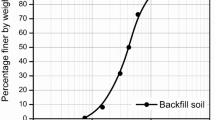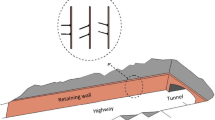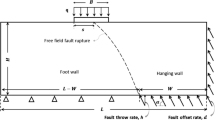Abstract
This paper presents a successful design of a strut-free excavation retaining system, namely the TPKE project. The TPKE excavation project was 13.2 m deep, covering approximately 127 × 105 m which is considered as a large excavation. Considering the cost saving and construction period shortening, the configurations of the diaphragm walls, buttress walls, cross walls, and the capping slab were used to design a strut-free excavation retaining system. This is feasible through the three-dimensional finite element analysis. This project was successfully completed with the maximum diaphragm wall deflection to the excavation depth ratio of 0.25%. A set of parametric studies was conducted to investigate the mechanism of this retaining system. For reducing wall deflections, it can be concluded that increasing the number of cross walls and increasing the length of the buttress walls was more effective than increasing the number of buttress walls. Moreover, increasing the depth of buttress walls below the excavation level was insignificant to reduce wall deflections.















Similar content being viewed by others
Data availability statement
Data will be made available on reasonable request.
References
ACI 318–14 (2014) Building code requirements for structural concrete (ACI 318–14) and Commentary (ACI 318R-14). ACI Committee 318. Farmington Hills, MI, USA, pp 513
Calvello M, Finno RJ (2004) Selecting parameters to optimize in model calibration by inverse analysis. Comput Geotech 31(5):410–424. https://doi.org/10.1016/j.compgeo.2004.03.004
Hsiung BCB, Chung LJ, Lin MC (2020) Case record of phase 1 of Kaohsiung metro –geotechnical design and construction of a large-scale underground station. J GeoEng 15(4):205–214. https://doi.org/10.6310/jog.202012_15(4).4
Hsieh HS, Wu LH, Lin TM, Cherng JC, Hsu WT (2011) Performance of T-shaped diaphragm wall in a large scale excavation. J GeoEng 6(3):135–144. https://doi.org/10.6310/jog.2011.6(3).3
Hsieh PG, Ou CY (1998) Shape of ground surface settlement profiles caused by excavation. Can Geotech J 35(6):1004–1017. https://doi.org/10.1139/t98-056
Hsieh PG, Ou CY, Hsieh WH (2016) Efficiency of excavations with buttress walls in reducing the deflection of the diaphragm wall. Acta Geotech 11(5):1087–1102. https://doi.org/10.1007/s11440-015-0416-6
Hsieh PG, Ou CY (2018) Mechanism of buttress walls in restraining the wall deflection caused by deep excavation. Tunn Undergr Space Technol 82:542–553. https://doi.org/10.1016/j.tust.2018.09.004
Jaky J (1944) The coefficient of earth pressure at rest. J Soc Hung Archit Eng 78(22):355–358
Khoiri M, Ou CY (2013) Evaluation of deformation parameter for deep excavation in sand through case histories. Comput Geotech 47(1):57–67. https://doi.org/10.1016/j.compgeo.2012.06.009
Lin PY, Chang TK, Ho SK, Ho SP (2017) Excavation without internal support and its implications in construction management: a case study. J GeoEng 12(2):81–88. https://doi.org/10.6310/jog.2017.12(2).4
Lim A, Ou CY, Hsieh PG (2010) Evaluation of clay constitutive models for analysis of deep excavation under undrained conditions. J GeoEng 5(1):9–20. https://doi.org/10.6310/jog.2010.5(1).2
Lim A, Ou CY (2018) Performance and three-dimensional analyses of a wide excavation in soft soil with strut free retaining system. Int J Geomech 18(9):05018007. https://doi.org/10.1061/(asce)gm.1943-5622.0001165
Lim A, Ou CY, Hsieh PG (2020) A novel strut-free retaining wall system for deep excavation in soft clay: numerical study. Acta Geotech 15(6):1557–1576. https://doi.org/10.1007/s11440-019-00851-5
Lim A, Ou CY (2020) Performance of cross and buttress walls to control wall deflection induced by deep excavation in dense urban area. Geotech Eng J SEAGS AGSSEA 51:44–51
Ou CY, Chiou DC, Wu TS (1996) Three-dimensional finite element analysis of deep excavations. J Geotech Eng 122(5):337–345. https://doi.org/10.1061/(ASCE)0733-9410(1996)122:5(337)
Ou CY (2016) Finite element analysis of deep excavation problems. J GeoEng 11(1):1–12. https://doi.org/10.6310/jog.2016.11(1).1
Schanz T, Vermeer PA, Bonnier PG (1999) The hardening soil model: formulationand verification. In: Beyond 2000 in Computational Geotechnics. PLAXIS Internation
Zeng CF, Song WW, Xue XL, Li MK, Bai N, Mei GX (2021) Construction dewatering in a metro station incorporating buttress retaining wall to limit ground settlement: Insights from experimental modelling. Tunn Undergr Space Technol 116:104124. https://doi.org/10.1016/j.tust.2021.104124
Zeng CF, Powrie W, Xue XL, Li MK, Mei GX (2021) Effectiveness of a buttress wall in reducing retaining wall movement during dewatering before bulk excavation. Acta Geotech 16:3253–3267. https://doi.org/10.1007/s11440-021-01179-9
Zeng CF, Xue XL, Li MK (2021) Use of cross wall to restrict enclosure movement during dewatering inside a metro pit before soil excavation. Tunn Undergr Space Technol 112:103909. https://doi.org/10.1016/j.tust.2021.103909
Acknowledgements
The authors acknowledge the support provided by the Ministry of Science and Technology in Taiwan [grant number MOST 106-2221-E-146-002].
Funding
The authors have no relevant financial or non-financial interests to disclose.
Author information
Authors and Affiliations
Corresponding author
Additional information
Publisher's Note
Springer Nature remains neutral with regard to jurisdictional claims in published maps and institutional affiliations.
Rights and permissions
About this article
Cite this article
Yeh, TY., Ou, CY. & Lim, A. A case study of strut-free excavation retaining system. Acta Geotech. 17, 5557–5571 (2022). https://doi.org/10.1007/s11440-022-01526-4
Received:
Accepted:
Published:
Issue Date:
DOI: https://doi.org/10.1007/s11440-022-01526-4




